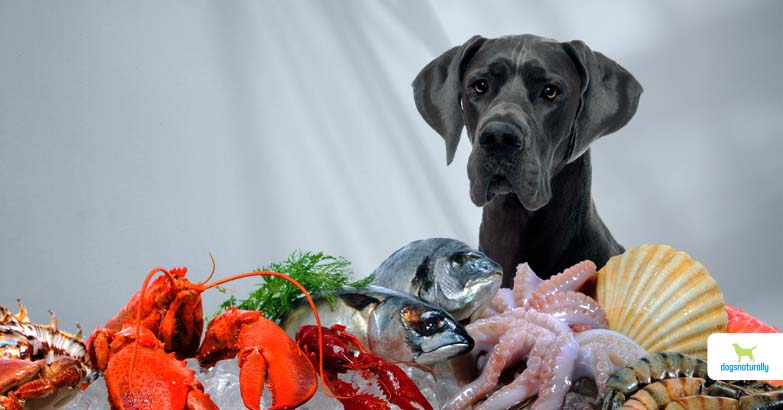Seafood can be a healthy addition to your dog’s diet … but some seafoods can add unnecessary and harmful toxins and heavy metals.
So … can dogs eat seafood? Let’s look at which seafoods you can safely feed your dog … and which ones should be left in the ocean.
Safe Seafoods For Dogs
Here are some healthy seafoods you can safely give your dog regularly.
Mussels
Mussels are an excellent food for dogs … especially green-lipped mussels. Green-lipped mussels come from New Zealand waters and they’re rich source of omega-3 fatty acids and minerals, as well as vitamins, amino acids, antioxidants and enzymes.
They’ll help your dog’s joints as well. They’re. a natural source of glycosaminoglycans (GAGS), which are the main components of cartilage and synovial fluid found in the joints. Studies have shown them to relieve discomfort and inflammation in dogs (and people!) suffering from arthritis. They support joint mobility, cartilage maintenance, cardiovascular health and help maintain healthy skin too.
You can buy green lipped mussel powders for dogs. Make sure the product you buy is cold extracted. Heat processing will destroy the nutrients. You can give about 15 mg of powder per lb of your dog’s body weight per day.
Another way to give your dog green lipped mussels is to buy freeze-dried mussels and give 2 mussels for every 10 lbs of bodyweight per day. Again, make sure the product you buy hasn’t been heat-treated.
Small Oily Fish
Sardines, smelts, herring, mackerel, anchovies … are all small oily fish that offer your dog a source of omega-3 fatty acids … as well as protein, calcium, selenium and niacin. In fact, giving whole fish is a much better way to give your dog omega-3 fatty acids than fish oil, which is very unstable and can easily become rancid.
Avoid larger fish that are higher up the food chain. These. can be contaminated with toxins like mercury and PCBs (carcinogenic chemicals called polychlorinated biphenyls), and aren’t as healthy for your dog.
But smaller fatty fish like sardines, smelts, herring, mackerel and anchovies are a healthy choice. If you buy fresh fish, t’s a good idea to freeze them for two weeks before feeding, to avoid any parasites that may be in some fish.
You can feed these fish whole and raw two or three times a week. Depending on your dog’s taste, give them either thawed or still frozen (some dogs prefer their fish crunchy).
You can feed these types of fish canned … preferably packed in water without added salt. For a 40-50 lb dog, give ¼ of a 3.75 oz can of small fish (again, sardines, mackerel, herrings or anchovies) per day along with other foods
Seafood To Feed Dogs Occasionally
These seafoods are good ones to feed occasionally … with some cautions.
Shellfish
Your dog can eat shellfish like shrimp, clams, mussels or oysters. These creatures are nutrient dense because they live in mineral rich waters.
Bivalves
Oysters, clams and mussels are bivalves (with hinged shells) that are generally rich in vitamin B12, protein, iron, zinc, copper, calcium, phosphorus and selenium, as well as omega-3 fatty acids. Because bivalves are low on the food chain, they’re low risk when it comes to heavy metal contamination.
Caution: Because bivalves are filter feeders, they can take up toxins from toxic microalgae such as dinoflagellates – tiny organisms that “bloom” in the summer, producing a neurotoxin that affects muscle function and can cause paralytic shellfish poisoning (PSP). Factors like temperate waters and seasons (late spring to early fall) and weather conditions can affect the level of toxins in seafood.
If you want to feed bivalves to your dog for the nutrients they provide, make sure they come from clean, cooler waters and suppliers who test their products for contamination.
Shrimp
Shrimp is a low calorie form of protein, and if you can get fresh, wild shrimp, it’s fine to share it with your dog (including the heads and tails you leave on your plate!).
Caution: Most shrimp in grocery stores are imported from a variety of countries (often without telling you where it’s from) and is farm-raised. This is a problem because shrimp farmers use antibiotics, disinfectants and pesticides to prevent shrimp disease. So imported shrimp commonly contain harmful chemicals.
Shrimp labeling is notoriously unreliable (at least 30% is misrepresented – even as to whether it’s wild or farm raised), so buy your shrimp from a trustworthy supplier who tells you the source.
RELATED: Can dogs eat shrimp? Read more ...
Salmon
Giving your dog fresh salmon can be a great way to provide him with omega-3 fatty acids as well as vitamin D. It’s an excellent source of protein and is rich in minerals like magnesium, potassium and iron. Also, most dogs love eating salmon, which you can feed raw.
Salmon can benefit skin, coat, immune system, cognitive function and has anti-inflammatory effects. But there are several things you need to know before feeding salmon to your dog.
Cautions: There are two cautions with salmon.
1. Don’t feed farmed salmon. Salmon farms use large amounts of antibiotics to prevent disease. Farmed salmon have also been shown to contain high levels of contaminants like PCBs (polychlorinated biphenyls), which are known cancer-causing chemicals.
2. Avoid genetically modified (GMO) salmon. While the US Food And Drug Administration (FDA) claims GMO salmon is safe, there have been no studies conducted on the long term effects of eating GMO salmon. And it’s also unlabeled so you could be buying it unknowingly.
So always make sure you buy wild salmon. Just be mindful of the potential for salmon poisoning. It comes from a parasite called Neorickettsia helminthoeca. This parasite is found in Pacific salmon, and while eating salmon doesn’t make bears or raccoons sick, it can make dogs ill and could be fatal if not treated promptly.
Freezing salmon for two weeks before feeding it should eliminate these parasites; but be careful if you’re out for a hike in the Pacific Northwest and your dog manages to scavenge dead salmon.
RELATED: Can dogs eat salmon? Learn the pros and cons …
Seafood To Avoid For Dogs
It’s best to find alternatives for these foods, as they can often be toxic or contaminated.
Fish Oil
Fish oil from many different kinds of fish has long been popular as a supplement for dogs. It provides omega-3 essential fatty acids like DHA and EPA that support a healthy immune system, reduce inflammation, and benefit skin and coat as well as cognitive function.
Unfortunately the good news ends there.
Fish oil is extremely sensitive to oxidative damage. When omega-3 fat particles are exposed to air, they break down into smaller compounds like MDA (malondialdehyde) and create oxygen-containing molecules called free radicals. Both MDA and free radicals cause premature aging and disease because they damage proteins, DNA and other cellular structures.
This is called oxidative stress and it causes inflammation in the body, leading to chronic health problems.
Fish oils can also contain heavy metals like arsenic, mercury, cadmium and lead, which can damage the nervous system and cause certain cancers as well as liver and kidney damage. Other contaminants like PCBs and dioxins can also be found in fish oils, causing an array of disorders including nervous and immune system issues, endocrine and reproductive disorders, skin problems and even some types of cancer.
If you still want to feed fish oil, make sure you ask your supplier for a Certificate of Analysis (COA) showing it’s been tested for contaminants. Buy an oil that’s in a dark colored glass container, keep it refrigerated and use it quickly. Every time you open the bottle, there’s more oxidation and more risk of the oil causing health issues.
RELATED: Read more about fish oil for dogs …
Krill Oil
Krill oil comes up a lot as an alternative to other fish oils. But there are issues with krill as well
First of all, sustainability is a huge potential issue. Many ocean dwellers, including whales, seals, penguins, squid and fish rely on krill for food. Companies that sell krill oil will usually tell you their harvesting is sustainable and that there’s plenty left for the creatures who need it to survive. The Marine Stewardship Council monitors these claims and you can verify them at the MSC website. (This is also a good place to check that other fish you’re buying is not endangered).
Second, while krill oil is more stable than other fish oils, it’s still susceptible to oxidation once you open the bottle. Krill oil does contain a natural antioxidant – astaxanthin – that prolongs the shelf life of krill. However, astaxanthin itself degrades very quickly, so its protective qualities are diminished over time.
Tilapia
Tilapia’s a very popular fish because of its mild flavor and relatively low cost – in fact it’s the 4th most consumed seafood in the US, after shrimp, tuna and salmon.
Tilapia is also the world’s second most farmed fish (after carp). This means that tilapia doesn’t offer a good nutrient profile, because farmed fish are usually fed GMO corn and soymeal based diets. Farmed tilapia is low in omega-3s because farmed fish don’t eat phytoplankton and other aquatic plants that provide these fats. And it’s also high in omega-6s … leading to an often-cited claim that “tilapia is worse than bacon.”
A high percentage of farmed tilapia comes from China where poor quality feeds are often used and fish live in overcrowded muddy ponds. This means that farmed fish usually contain high levels of pesticides and antibiotics used to prevent disease.
On the plus side, the Environmental Working Group (ewg.org) considers tilapia a safe choice in terms of mercury contamination.
If you want to feed tilapia, check first whether your tilapia has an Aquaculture Stewardship Council (ASC) seal. The ASC audits and certifies tilapia farms that have appropriate production standards. Only about 15 percent of tilapia available in the US carries this seal.
Large Fish
It’s safest to avoid giving your dog any larger fish. Fish to avoid include tuna, walleye, marlin, swordfish, shark, sturgeon and bluefish. Mercury gets into waters due to industrial waste run-off into lakes, rivers and the ocean. This means that mercury is present in a lot of fish … but it’s found at much higher levels in larger predator fish higher up the food chain, as they eat other smaller sea creatures.
Mercury “bioaccumulates” in these predators, so eating larger fish can create a number of health issues. Mercury toxicity is serious and it’s increasing. It accumulates in our bodies over time and causes problems ranging from nervous system disorders to endocrine issues, reproductive problems and accelerated aging.
And if you’re giving your dog canned tuna (or eating it yourself), be aware that the mild tasting white albacore tuna is almost three times higher in mercury than skipjack tuna, used in most canned light tuna. If you want to feed canned fish, canned salmon from Alaska is relatively low in contaminants.
So if you want to give your dog seafood, there are several healthy choices. Just be aware of certain fish to avoid or feed in lower amounts.












